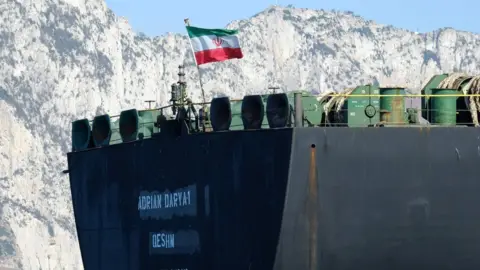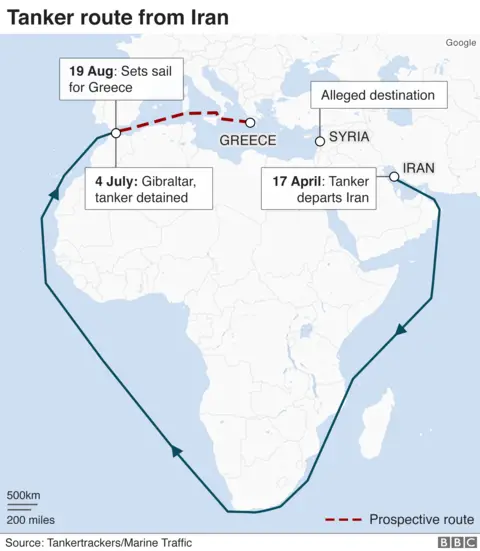Iran tanker row: Greece closes out ship after US warnings
 AFP/Getty
AFP/GettyGreece has refused to help the Iranian tanker recently detained in Gibraltar on suspicion of shipping oil to Syria.
Deputy foreign minister Miltiadis Varvitsiotis told broadcaster ANT1 his country was "not willing to facilitate the course of this ship to Syria".
The move comes after US Secretary of State Mike Pompeo threatened sanctions on any country that helps the tanker.
Adrian Darya-1 left Gibraltar on Sunday and listed the Greek port Kalamata as its destination.
Authorities in the British territory detained the tanker in July. It was previously known as Grace 1.
Despite a last minute US request, Gibraltar lifted its detention order on Friday and the tanker departed east into the Mediterranean.
Tehran has previously said it was willing to send naval forces to escort the Adrian Darya-1. It is currently north of the Algerian port of Oran.
What did Greece say?
According to local media, Mr Varvitsiotis confirmed the US had put pressure on Greece to deny any help to the tanker. Iran has not been in touch with the Greek government, he said.
In any case, the Adrian Darya-1 - which is carrying 2 million barrels of crude oil - is too large for any Greek port to accommodate, Mr Varvitsiotis said.
Asked how Greece would respond if the tanker dropped anchor in its waters, he replied: "In that case we will see what will happen."
The US believes Adrian Darya-1 has links to Iran's Revolutionary Guard - a branch of the country's armed forces that the US has designated a terrorist organisation.
"We want to deny them the resources to continue their horrific terror campaign," Mr Pompeo told reporters.
"We have made clear that anyone who touches it, anyone who supports it, anyone who allows a ship to dock is at risk of receiving sanctions from the United States," he said, adding the US would take "every action we can" to stop the tanker from heading to Syria.
Where is the ship heading?
Adrian Darya-1 still lists Kalamata as its destination.
Samir Madani, one of the founders of the maritime traffic site TankerTrackers.com, told the BBC he believed the ship was trying to return to Iran through the Suez Canal.
"They will have to offload around a million barrels to another vessel, most likely with an Iranian flag as well, in order to do so because she is too heavily laden in the water," he said. "To go to Syria she's also too heavily laden to deliver to [the port of] Baniyas without assistance."
The tanker took a circuitous route to the Mediterranean, travelling around the entirety of Africa instead of through the far shorter and quicker Suez Canal.
"They don't have to ship all the way around Africa in order to reach Syria," Mr Madani says. Their analysts believe the ship was heading to Syrian waters as a safe haven, from where they could offload oil to smaller ships for delivery across the Mediterranean. "It could be buyers in southern Europe, for instance," he said.
What's the background to the tanker dispute?
The ship with its crew of 29 - from India, Russia, Latvia and the Philippines - was seized with the help of British marines on 4 July, after the government of Gibraltar - a British territory - suggested it was heading for Syria in breach of EU sanctions.
The move sparked a diplomatic crisis between the UK and Iran, which has escalated over recent weeks and saw Iran seize a British-flagged and Swedish-owned oil tanker, Stena Impero, in the Gulf.
Stena Impero remains in Iranian detention. There had been speculation of a swap if Grace 1 was freed, despite official denials.
A spokesman for the Iranian foreign ministry said on Monday they were waiting for a court order before any possible release of the ship but said there was "no connection whatsoever" between the two ship seizures.


